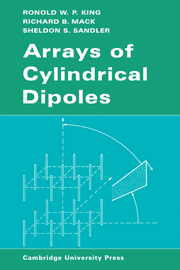Book contents
- Frontmatter
- Contents
- Preface
- CHAPTER 1 INTRODUCTION
- CHAPTER 2 AN APPROXIMATE ANALYSIS OF THE CYLINDRICAL ANTENNA
- CHAPTER 3 THE TWO-ELEMENT ARRAY
- CHAPTER 4 THE CIRCULAR ARRAY
- CHAPTER 5 THE CIRCUIT AND RADIATING PROPERTIES OF CURTAIN ARRAYS
- CHAPTER 6 ARRAYS WITH UNEQUAL ELEMENTS; PARASITIC AND LOG-PERIODIC ANTENNAS
- CHAPTER 7 PLANAR AND THREE-DIMENSIONAL ARRAYS
- CHAPTER 8 TECHNIQUES AND THEORY OF MEASUREMENT
- Appendix I Tables of ΨdR, T(m) or T′(m) and self- and mutual admittances for single elements and circular arrays
- Appendix II Summary of the two-term theory for applications
- Appendix III Summary of formulas for the curtain array
- Appendix IV Tables of admittance and impedance for curtain arrays
- Appendix V Programme for Yagi-Uda array
- References
- List of symbols
- Index
Appendix II - Summary of the two-term theory for applications
Published online by Cambridge University Press: 24 May 2010
- Frontmatter
- Contents
- Preface
- CHAPTER 1 INTRODUCTION
- CHAPTER 2 AN APPROXIMATE ANALYSIS OF THE CYLINDRICAL ANTENNA
- CHAPTER 3 THE TWO-ELEMENT ARRAY
- CHAPTER 4 THE CIRCULAR ARRAY
- CHAPTER 5 THE CIRCUIT AND RADIATING PROPERTIES OF CURTAIN ARRAYS
- CHAPTER 6 ARRAYS WITH UNEQUAL ELEMENTS; PARASITIC AND LOG-PERIODIC ANTENNAS
- CHAPTER 7 PLANAR AND THREE-DIMENSIONAL ARRAYS
- CHAPTER 8 TECHNIQUES AND THEORY OF MEASUREMENT
- Appendix I Tables of ΨdR, T(m) or T′(m) and self- and mutual admittances for single elements and circular arrays
- Appendix II Summary of the two-term theory for applications
- Appendix III Summary of formulas for the curtain array
- Appendix IV Tables of admittance and impedance for curtain arrays
- Appendix V Programme for Yagi-Uda array
- References
- List of symbols
- Index
Summary
To facilitate practical applications of the theory apart from its detailed development and verification, principal points of the two-term theory, together with the steps required in its utilization, are summarized in this appendix. Numerical results for arrays containing only a few elements can be computed by hand with the aid of the tables in appendix I or those in the literature [1]. Calculations for larger arrays or for element parameters not included in the tables generally require a computer. For these applications, the theory can be conveniently packaged as a computer programme to which the user need only supply input data cards specifying the parameters of the elements and array to obtain a numerical evaluation of any properties of the array [2]. In this form, the theory can be used without considering either intricate mathematics or complicated programming steps once the initial programming is completed. In a reasonably general programme, the parameters that can be specified as input data are the number N of antennas in the array, their radius a, length 2h, spacing d, and the relative driving voltages Vi or currents Ii(0).
The theory applies to arrays of thin, identical, parallel, non-staggered, centre-driven, highly conducting dipoles which are uniformly spaced around a circle. If the admittances and currents are multiplied by two, they also apply to arrays of vertical monopoles over a large highlyconducting ground plane.
- Type
- Chapter
- Information
- Arrays of Cylindrical Dipoles , pp. 414 - 421Publisher: Cambridge University PressPrint publication year: 1968



